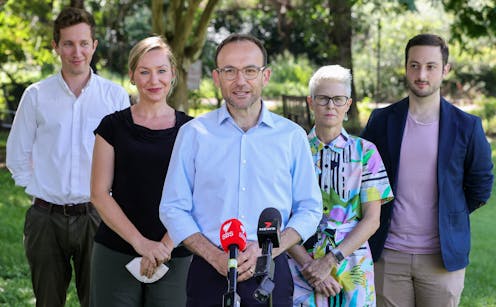Polls show a jump in the Greens vote – but its real path to power lies in reconciling with Labor
- Written by Kate Crowley, Adjunct Associate Professor, Public and Environmental Policy, University of Tasmania

A major poll published yesterday suggests the Greens are set to grow as a political force at this month’s election, showing its primary vote has risen markedly from 10% in 2019 to a current high of 15%.
Recent surveys show large numbers of voters see climate change as their biggest concern, and the jump in Greens’ support indicates the issue is determining the way many people plan to vote.
The party goes to next month’s election armed with ambitious, big-spending policies. It strongly fancies its chances in at least five lower house seats and hopes to pick up three more Senate seats.
But for the Greens, the path to real power lies in a hung parliament where they can seek to extract policy concessions from a minority Labor government. The Greens and Labor have a mixed record of working together, but can learn from past experience. So let’s take a closer look at what we can expect from the Greens in a hung parliament.
Seeking the balance of power
Opinion polls earlier in the election campaign put the Greens at between 11% and 13% of the primary vote.
In 2010 they polled 11.76% in the House of Representatives (giving them a shared balance of power) and 13% in the Senate (delivering the balance of power outright).
The 2010 election led to the first federal hung Parliament in 70 years, although these are common outcomes in the states and territories. Labor Prime Minister Julia Gillard’s deal with the Greens in 2010 to form a minority government ended acrimoniously.
Labor leader Anthony Albanese has ruled out such a power-sharing deal this time around, as Bill Shorten did ahead of the 2016 and 2019 elections.
But if a hung parliament does eventuate and Labor refuses a power-sharing deal, it would be left clinging to power, vote by vote. In any case, Labor would have to negotiate support from the Greens and independents in order to govern – and offer a swag of policy concessions in return.
The Greens are also a chance of recapturing the balance of power in the Senate, which means their influence after May 21 may still be significant.
Read more: Labor's lead steady in Newspoll and gains in Resolve; how the polls moved during past campaigns
The ability to influence policy is key to the legitimacy and relevance of minor parties such as the Greens.
Under the Gillard Labor minority government, the Greens had significant policy success. They pushed Labor towards a carbon pricing policy that briefly turned around energy emissions growth, and a dental health package for children and low-income earners.
These signature policies were short-lived though; abolished by Abbott Coalition government after the 2013 election.
Some Green initiatives survived, however, such as the Parliamentary Budget Office, the Clean Energy Finance Corporation and the Australian Renewable Energy Agency.
Relations between Labor and the Greens eventually failed once the Gillard government adopted a watered-down mining tax. The Greens also decried Labor’s failure to make headway on environmental protection, national heritage, the Great Barrier Reef, Tasmania’s wilderness, the Murray Darling Basin and more.
So what policy demands can we expect from the Greens this time around?
A big policy agenda
In the case of a hung parliament, the Greens would demand a halt to all new coal, gas and oil projects for at least six months while they negotiate with Labor over climate policy. It would also push for a coal export levy to fund disaster recovery and clean export industries.
In their 2022 electoral platform, the Greens are again aiming high. Their headline policies include:
- a treaty with First Nations people
- free dental and mental healthcare
- wiping out student debt
- building one million publicly owned, affordable, sustainable homes
- overhauling labour laws to outlaw insecure work and increase wages.
Should the Greens hold the balance of power, they would likely also call for the next government to urgently release the delayed State of the Environment report, and to implement the recommendations from a 2020 independent review into Australia’s environment laws.
The party’s environment platform offers the usual extensive suite of policies and detailed measures to address the extinction crisis, green jobs, clean water, caring for country, sustainable agriculture, preventing animal cruelty, eliminating single-use plastics and improving ocean health.
As well as phasing out coal, oil and gas, the Green’s climate policy includes:
- banning political donations from fossil fuel companies
- installing cleaner, cheaper power for homes and business
- assisting workers in the clean energy transition
- funding climate resilience
- supporting cleaner cars, electricity and manufacturing.
Their energy plan allocates A$17.1 billion to electrify Australian homes, $14.8 billion electrifying small businesses and $12.6 billion installing small-scale solar batteries.
Read more: If it needs it, Australia can draw on significant experience of minority government
Where next for the Greens?
If the polls are right, the Greens are a chance to reclaim the balance of power in the Senate and to share the balance of power in the House of Representatives.
In the longer term, the Greens aspire to replace Labor in government. But as experience in Tasmania and the ACT shows, Greens ministers can successfully serve in Labor cabinets.
For now, the Greens are nipping at the heels of the major parties. The party’s best prospects for realising its policies in national government lie in reconciling with Labor and learning to work in coalition.
Read more: Albanese pledges to make gender pay equity a Fair Work Act objective
Authors: Kate Crowley, Adjunct Associate Professor, Public and Environmental Policy, University of Tasmania





